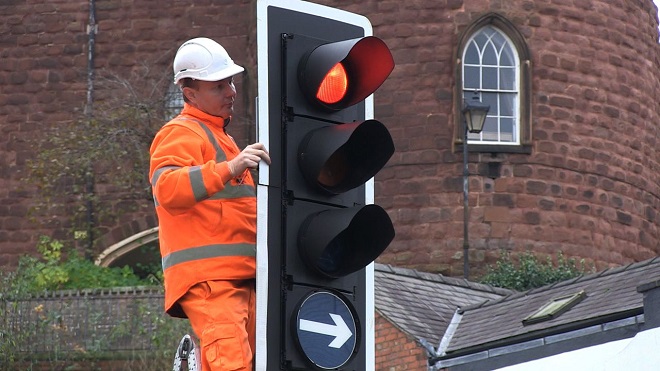Video and blog
In Shropshire, as elsewhere, the volume of traffic continues to grow and it has become increasingly important to provide a safe environment for pedestrians.
In this blog, and the video below, we look at the work Shropshire Council carries out to inspect and maintain Shropshire’s traffic lights, signals and crossings, to help people to safely cross the road.
Video: How we inspect and maintain traffic lights and signals
What signals and crossings do we look after?
- 36 signal controlled junctions
- 35 pelican crossings
- 30 puffin crossings
- 17 toucan crossings
- 58 zebra crossings
- 107 vehicle activated signs
- 45 school crossing signs
- 10 cattle crossing signs
What are the different types of crossings?
- Signal-controlled junctions are normal traffic signals at junctions that give priority to different streams of traffic. Most also include facilities to control pedestrian crossing.
- Pelican crossings have the green man indicator at the opposite side of the road to the pedestrians. These crossings have a flashing green man and a flashing amber traffic light.
- Puffin crossings have a pedestrian indicator on the same side as the pedestrian. There is no flashing green man or flashing amber traffic light.
- Toucan crossings allow both cyclists and pedestrians to cross and show green cycle symbol and a green man.
- Zebra crossings are designated places for pedestrians to cross the road. Belisha beacons -- amber-coloured globe lamps on top of black and white pole -- offer extra visibility to zebra crossings for motorists, particularly at night.
- Vehicle Activated Signs (VAS) are the electronic displays that flash up the speed limit, or other sign to give a clear warning of an approaching hazard. The signs are usually activated at a pre-set trigger speed by the approach of a vehicle.
In addition to the above, we also operate an Urban Traffic Management and Control (UTMC) system which connects a total of 12 signalised junctions in two corridors:
- One through Shrewsbury town along the Smithfield Road corridor.
- One on the Whitchurch Road/Battlefield Road approach to Shrewsbury.
The UTMC system allows us to provide timely, accurate traffic and travel information, and warn people in advance of problems on the road network.
Find out more information about pedestrian crossings here.
How do we monitor and repair traffic lights and crossings?

There are a number of sites which are remotely monitored so that most faults are reported automatically and repaired promptly.
However, we also encourage people to contact us to report any faults with lights or signals.
Maintenance of all signal equipment is currently carried out Dynniq (formerly Imtech UK) on behalf of Shropshire Council.
Shropshire Council records any faults, then instructs Dynniq to carry out a speedy repair. We’ll then check on the standard of the completed repair.
Repair of signals is prioritised based on the type of fault to make sure that any fault which causes immediate danger is dealt with first; for example, a red light that isn’t working.
Note: Traffic signals or pedestrian crossings on the A49 south of Shrewsbury, and on the A5 Shrewsbury bypass, are the responsibility of Highways England. If you see a problem with any of these sites you should advise Highways England direct.
What improvements have we made?
We’ve improved operation and co-ordination of traffic signals in our major towns. We’ve been updating equipment to enable the use of more intelligent traffic control systems to respond to live demands, and minimise congestion and delay.
We’ve also made changes to the equipment installed to take advantage of new technologies which has already shown significant reductions in our energy consumption.
What else do we do?
We’re responsible for:
- Providing and/or approving designs for new traffic signal installations within the Shropshire area, from feasibility studies to implementation and commissioning.
- Advising on technical aspects of any contract requiring provision of traffic signal equipment.